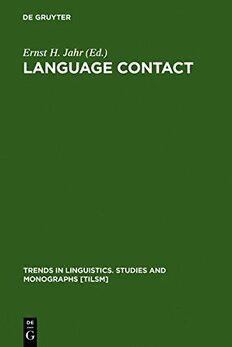
Language Contact: Theoretical and Empirical Studies PDF
Preview Language Contact: Theoretical and Empirical Studies
Language Contact Trends in Linguistics Studies and Monographs 60 Editor Werner Winter Mouton de Gruyter Berlin · New York Language Contact Theoretical and Empirical Studies Edited by Ernst Häkon Jahr Mouton de Gruyter Berlin · New York 1992 Mouton de Gruyter (formerly Mouton, The Hague) is a Division of Walter de Gruyter & Co., Berlin. © Printed on acid-frec paper which falls within the guidelines of the ANSI to ensure permanence and durability. Library of Congress Cataloging-in-Publication Data Language contact : theoretical and empirical studies / edited by Ernst Häkon Jahr. p. cm. — (Trends in linguistics. Studies and mono- graphs: 60) Based on a symposium held Sept. 1989 at the University of Tromso. Includes bibliographical references and in- dex. ISBN 3-11-012802-0 (acid-free paper) : 1. Languages in contact-Congresses. 2. Sociolinguistics- Congresses. I. Jahr, Ernst Häkon, 1948— II. Series. P130.5,L34 192 306-4'4-dc20 92-8084 CIP Die Deutsche Bibliothek — Cataloging-in-Publication Data Language contact ; theoretical and empirical studies / ed. by Ernst Häkon Jahr. — Berlin ; New York : Mouton de Gruyter, 1992 (Trends in linguistics : Studies and monographs ; 60) ISBN 3-11-012802-0 NE: Jahr, Ernst Häkon [Hrsg.]; Trends in linguistics / Studies and monographs © Copyright 1992 by Walter de Gruyter & Co., D-1000 Berlin 30 All rights reserved, including those of translation into foreign languages. No part of this book may be reproduced or transmitted in any form or by any means, electronic or mechanical, including photocopy, recording, or any information storage and retrieval system, without permission in writing from the publisher. Typesetting: Arthur Collignon GmbH, Berlin. — Printing: Gerike GmbH, Berlin. — Binding: Lüderitz & Bauer, Berlin. — Printed in Germany Preface The present volume has grown out of the Fifth International Tromso Symposium on Language held at the University of Troms0 in September 1989. The theme of the symposium was "Language Contact". Ten of the twelve papers included in this volume were first presented and discussed at the Tromso symposium. (Peter Trudgill's paper was not presented at the symposium, and Peter Neide presented a different paper from that included here.) Thanks are due to the University of Tromse, the School of Languages and Literature (University of Tromso), and the Norwegian Research Council for the Humanities, all of which supported the symposium financially. Ernst Häkon Jahr Contents Introduction 1 Knut Bergsland Language contacts between Southern Sami and Scandinavian . .. 5 Tove Bull A contact feature in the phonology of a northern Norwegian dialect 17 Ian Hancock The social and linguistic development of Scandoromani 37 Even Hovdhaugen Language contact in the Pacific: Samoan influence on Tokelauan 53 Robert B. Le Page "You can never tell where a word comes from": language contact in a diffuse setting 71 Marianne Mithun The substratum in grammar and discourse 103 Brit Maehlum Dialect socialization in Longyearbyen, Svalbard (Spitsbergen): a fruitful chaos 117 Peter H. Neide Ethnolinguistic minorities within the European community: migrants as ethnolinguistic minorities 131 Jorgen Rischel Isolation, contact, and lexical variation in a tribal setting 149 Andree Tabouret-Keller Language contact in focused situations 179 Peter Trudgill Dialect typology and social structure 195 Werner Winter Borrowing and non-borrowing in Walapai 213 Subject Index 229 Introduction Since the publication of Uriel Weinreich's Languages in Contact (1953), the study of language contact has been extensive. However, we still lack an overall theory of language contact. Empirical data have been collected from many languages and language-contact situations around the world, but no one has as yet formulated a theory that can be said to account for all — or most of — the empirical data. This is unfortunate, since it is obvious that language-contact studies would make considerable pro- gress if we were able to develop a more advanced framework of theoretical generalizations. It would be a great help if we had a language laboratory where we could experiment with, and study the outcome of, various kinds of language contact situations. But, of course, we do not have and cannot get such laboratories. What we can do, however, is look for areas of the world where the conditions for mapping out the different important and, perhaps, decisive factors are better than in other regions. The papers in this volume suggest several such promising areas. It is of great importance for the further development of language contact studies that fresh empirical data from "new" and typologically different languages and language contact areas are collected, described, and discussed. Such new data will contribute to broadening the basis for theoretical generalizations concerning linguistic and sociolinguistic effects of language contact. In that way, stimulating suggestions and new ap- proaches may be brought forward, leading, hopefully, to new theoretical insights. By trying to generalize theoretically from specific case studies of language contact around the world, eventually we can hope to be able to formulate an overall theory of language contact. The present volume is intended to be a contribution to this develop- ment. It contains twelve papers in which different languages from various parts of the world are described and discussed in a language-contact perspective. It covers a wide range of languages, societies, and language- contact situations, from North American Indian languages to the dialect- contact situation of Longyearbyen — the Norwegian town on Spitsber- gen, situated right under the North Pole on the 78th parallel; from the
